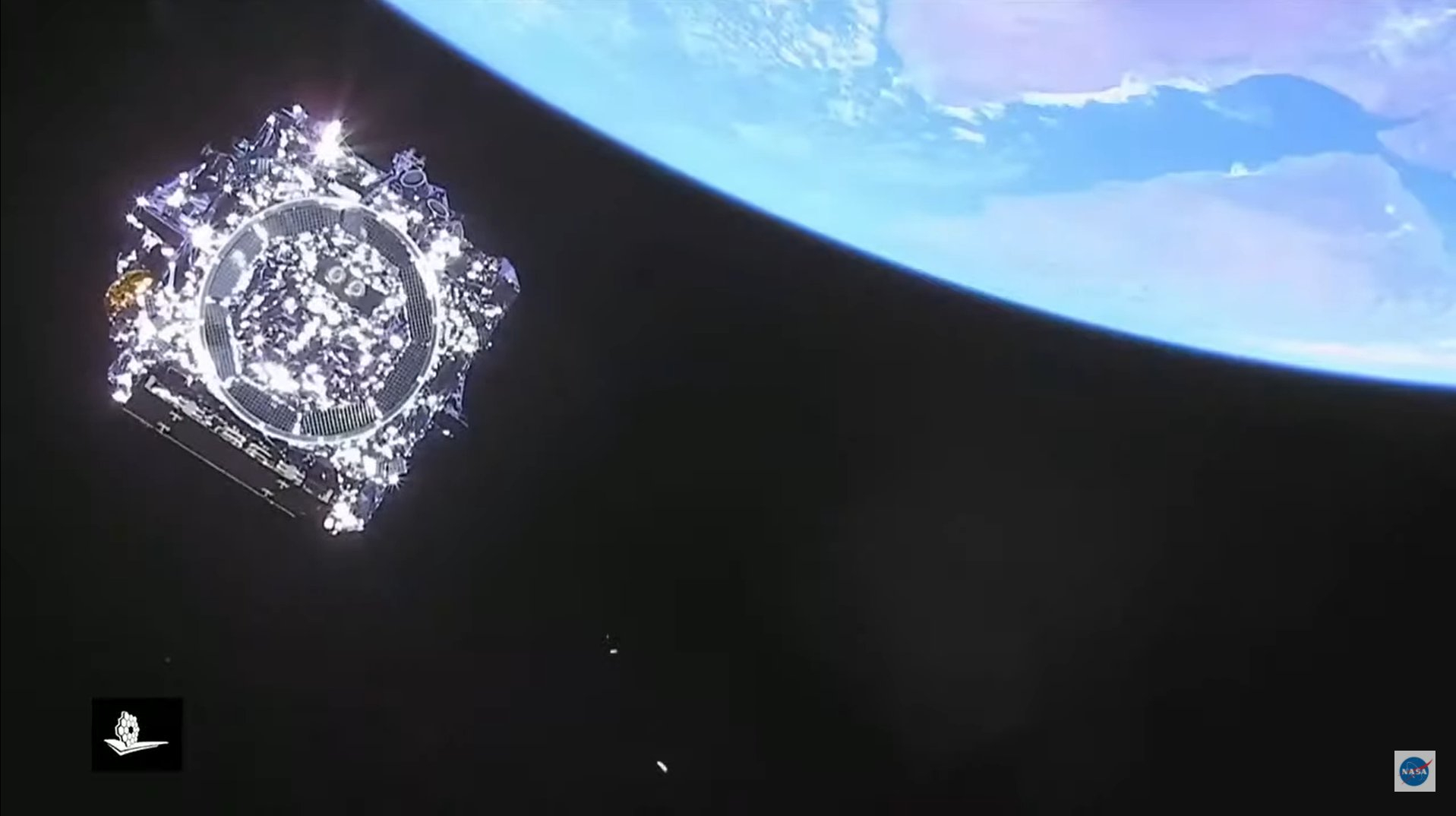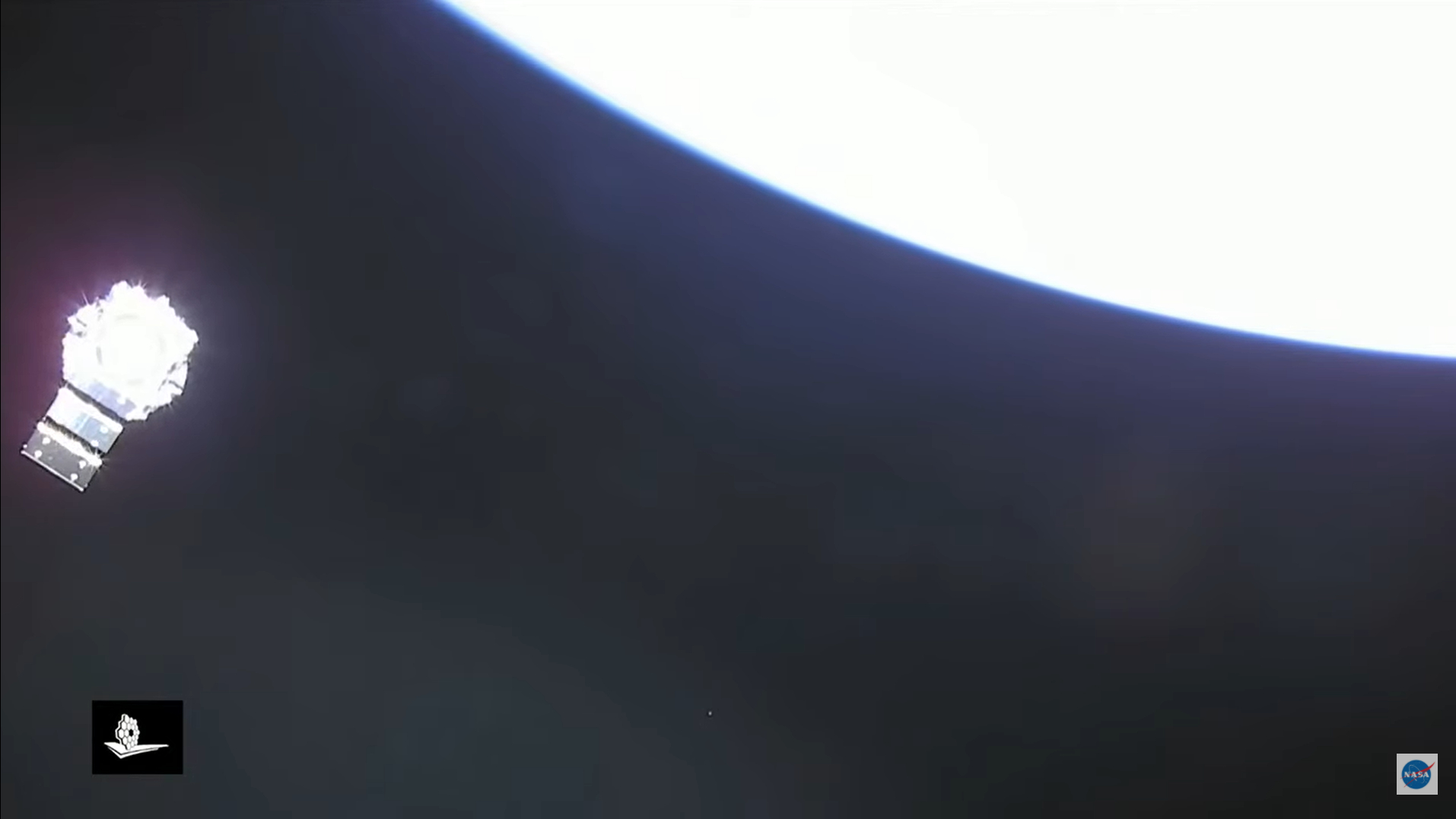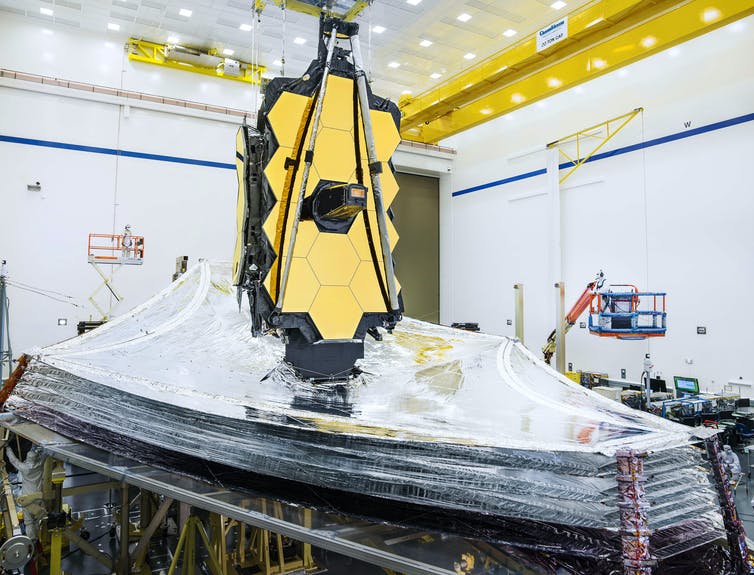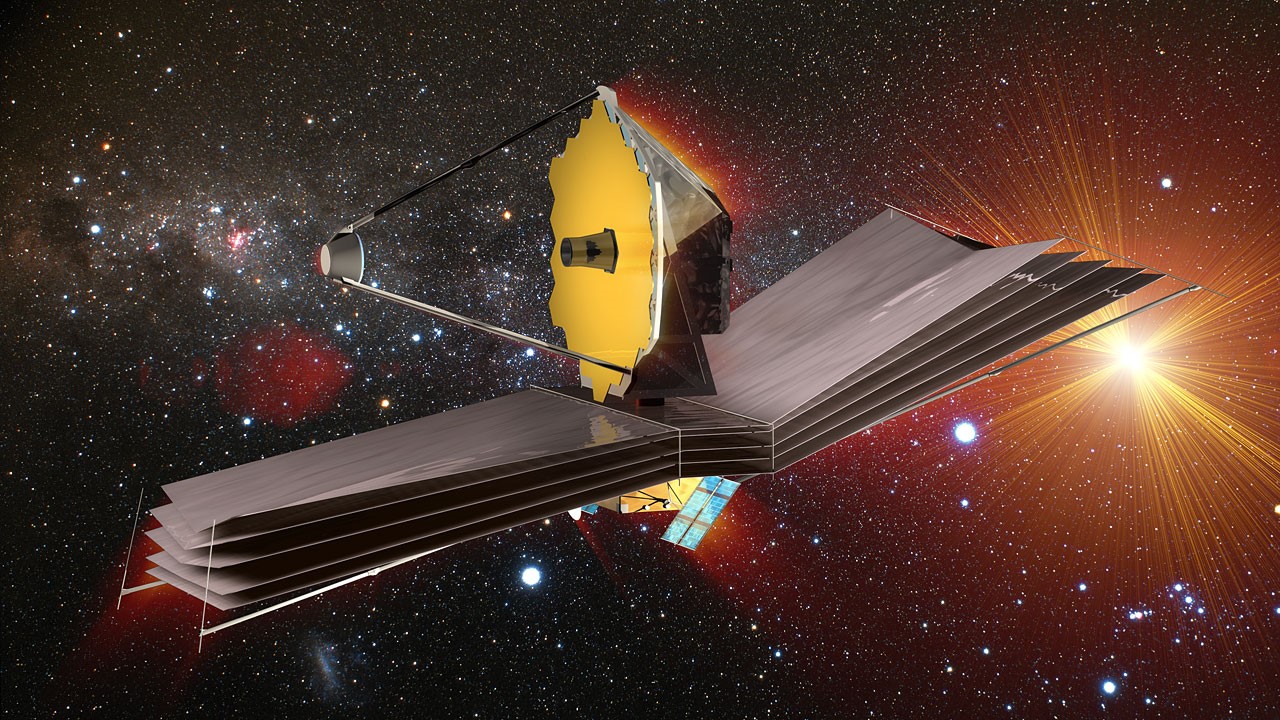NASA just got a $10 billion space telescope for Christmas.
An Ariane 5 rocket launched today (Dec. 25) from Europe's Spaceport in Kourou, French Guiana, at 7:20 a.m. EST (1220 GMT; 9:20 a.m. local time in Kourou), carrying the highly anticipated, long-delayed James Webb Space Telescope — and the hopes and dreams of countless astronomers, astrophysicists and planetary scientists around the world — into the final frontier.
The huge telescope will peer at the universe's first stars and galaxies, sniff the atmospheres of nearby alien planets and perform a variety of other high-profile, high-impact work over the next five to 10 years, if all goes according to plan.
The space telescope soared into a cloudy sky over Kourou and separated from its its Arianespace-built rocket about a half-hour later. Cheers erupted out at launch control as live views of Webb floating away and unfolding its solar array reached Earth.
"Go, Webb, go!" rang one cheer from an Arianespace flight controller on NASA's live broadcast.
Related: How the James Webb Space Telescope works in pictures
More: James Webb Space Telescope: Live updates



"This is a one-of-a-kind" mission, NASA Administrator Bill Nelson told Space.com last week. "It is the most advanced technology that is going to, if successful, open up secrets of the universe that will be just stupendous, if not almost overwhelming, [providing a] quantum leap of understanding of who we are, how we got here, what we are and how did it all evolve."
Get the Space.com Newsletter
Breaking space news, the latest updates on rocket launches, skywatching events and more!
"If successful" is a required caveat for every mission. But stressing it seems especially necessary with Webb, given the observatory's outsized importance and intricacy.
Webb is "the most complex thing, by far, that NASA has ever done," Webb Deputy Senior Project Scientist Jonathan Gardner, of NASA's Goddard Space Flight Center in Greenbelt, Maryland, told Space.com. "It's arguably the biggest pure science project that the United States has ever done."
Thirty years of work
Webb has been in the works for more than three decades. The ball first got rolling in September 1989, when a group of astronomers met at the Space Telescope Science Institute in Baltimore to discuss a possible successor to the Hubble Space Telescope.
Hubble hadn't even launched yet, but big space telescopes take a long time to plan and build, so the astronomy community tends to think a decade or two in advance. And in this particular case, there was a strong desire to minimize the chance of a long observing gap between Hubble and a "Next Generation Space Telescope" (NGST), as the successor was informally called.
Hubble launched to Earth orbit successfully in April 1990, but it soon became apparent that something was very wrong: The first images the scope returned were disappointingly blurry. This unexpected development had a chilling effect on planning for the NGST, said Robert Smith, a history professor at the University of Alberta in Canada who has written extensively about Hubble and other astronomy missions.

"Things really [weren't] moving very much as a consequence," Smith said during a presentation last week with NASA's Future In-Space Operations working group, referring to the status of the NGST's development at the time. "The priority [was] to fix Hubble."
Spacewalking astronauts did just that in December 1993, installing corrective optics and replacement instruments that compensated for a flaw in Hubble's 7.9-foot-wide (2.4 meters) primary mirror. The fix allowed NGST work to move forward again, Smith said — but more than three years of planning time had been lost, or at least compromised.
By the mid-1990s, a consensus had emerged that the NGST should study the very early universe. Hubble had by then provided looks at the cosmos as it was just one billion years after the Big Bang (which occurred 13.8 billion years ago), Gardner said. But the astronomy community wanted to probe even more deeply — ideally, all the way back to the epoch of the very first stars and galaxies, which likely formed within the first few hundred million years of the universe's existence.
Related: Building the James Webb Space Telescope (gallery)
That overarching ambition meant the new scope should be optimized to detect and analyze infrared light, which we feel as heat — a key difference from Hubble, which views mainly in optical and ultraviolet (UV) wavelengths. After all, the optical and UV emissions from the first stars and galaxies have been stretched so much by the universe's ongoing expansion that we see them now in longer infrared wavelengths. And infrared light travels better than its higher-energy counterparts, more easily penetrating the clouds of dust and gas that pepper the cosmos.
The new observatory would have to be big, too, to collect enough deep-space photons to study. The original concept called for a primary mirror at least 13.2 feet (4 m) wide. But then-NASA chief Daniel Goldin encouraged the NGST team to think even bigger, and a 26.4-foot-wide (8 m) mirror soon became part of the plan.
The basic design of the NGST was pretty much in place by 1996, Smith said. Around that time, researchers estimated that the powerful observatory would cost around $1 billion and launch as early as 2007. Those figures, we can now see, were wildly optimistic.
By 2010, the expected price tag had soared to around $5 billion and the targeted launch had slipped to 2014, even though the observatory had been descoped a bit. (Its mirror diameter had been reduced to 19.7 feet to 21.3 feet, or 6 m to 6.5 m.) There was mounting concern that the ever-growing appetite of the mission — which was officially named in September 2002, after Apollo-era NASA chief James Webb — could end up starving other NASA astrophysics projects, a feeling captured by a 2010 story in the journal Nature called "The telescope that ate astronomy."
The low point came in July 2011, when the House Appropriations Committee proposed canceling Webb. Scientists and influential politicians such as then U.S. Sen. Barbara Mikulski (D-Maryland) fought for the project, however, getting its head off the chopping block a few months later.
The universe: Big Bang to now in 10 easy steps
A hugely powerful and complex eye on the sky
Webb was always going to be a spectacularly big and complicated machine. Its ambitious observing goals dictated as much.
For example, the telescope must keep its scientific instruments extremely cold; any significant thermal emission from them would swamp the faint infrared signals Webb is after. The target operating temperature for the observatory is around minus 370 degrees Fahrenheit (minus 220 degrees Celsius), which the spacecraft will achieve via a two-pronged strategy.
One of those prongs is a five-layer sunshield, each sheet of which is the size of a tennis court. The other is location: Webb is headed not to Earth orbit but to a gravitationally stable spot 930,000 miles (1.5 million kilometers) from our planet known as the Sun-Earth Lagrange Point 2 (L2).
"What is special about this orbit is that it lets the telescope stay in line with the Earth as it moves around the sun," NASA officials wrote in an L2 explainer. "This allows the satellite's large sunshield to protect the telescope from the light and heat of the sun and Earth (and moon)."
L2 is too far away for astronauts to visit, so Webb will be on its own out there; Hubble-like servicing missions are not part of the plan for the giant new scope.
The fully extended sunshield and primary mirror are both too wide to fit inside the payload fairing, or protective "nose cone," of the Ariane 5 or any other currently operational rocket. So both elements launched today in a compact configuration and will unfold during Webb's stay in space.

The mirror consists of 18 hexagonal segments, each of which is made of beryllium and coated with a thin layer of gold. Combined, those 18 pieces weigh just 1,375 pounds (625 kilograms) here on Earth — about 800 pounds (360 kg) less than Hubble's single-piece primary mirror, which features just one-sixth the light-collecting area. (The overall mass of James Webb is about 6,500 kg, or 14,300 pounds on Earth, a little over half that of Hubble.)
The photons grabbed by the mirror will be analyzed by four scientific instruments — the Near-Infrared Camera (NIRCam), the Near-Infrared Spectrograph (NIRSpec), the Mid-Infrared Instrument (MIRI) and the Fine Guidance Sensor/Near Infrared Imager and Slitless Spectrograph (FGS/NIRISS).
Together, this quartet will allow Webb to see deeply throughout time and space. If all goes according to plan, the telescope will detect cosmic objects 10 billion times fainter than the dimmest star you can see in the night sky without a telescope. That's 10 to 100 times fainter than anything Hubble can pick up, NASA officials said. And Webb's vision will be so sharp that it can see details the size of a penny from 24 miles (40 km) away, they added.
Developing all of this advanced scientific and engineering tech took lots of time and money. But even more went into making sure that it will work as planned once Webb got to space, Gardner said.
"We had to put everything through vibration and acoustic testing at the levels that it will get during the launch, and then we had to put it in a vacuum chamber and make sure that everything worked in vacuum at the operating temperature," he told Space.com.
"All of that testing was to make sure that it would work," Gardner said. "And sometimes the testing would find something, and we'd have to go back and fix it and then redo the test. That's happened a few times, and that's fundamentally the reason why it took so long."
The testing campaign was led by NASA and aerospace company Northrop Grumman, the prime contractor for the mission. The European Space Agency (ESA) and Canadian Space Agency (CSA) are also major Webb partners. ESA provided launch services, NIRSpec and MIRI's optical system, for example, and CSA contributed the FGS/NIRISS instrument.
Like most of humanity's endeavors, the Webb project was also impacted by COVID-19. Complications imposed by the coronavirus pandemic contributed to a recent delay that pushed the targeted launch date from March 2021 to October 2021.
A few more minor delays followed, but Webb finally got off the ground today, 14 years later than originally anticipated. The final price tag, roughly $10 billion, ended up being higher than hoped as well. That's a lot of money, but it's not exactly out of bounds for such a big and complex space mission. For instance, a 2017 report by the U.S. National Academies of Sciences, Engineering and Medicine estimated Hubble's cumulative cost at that point to be nearly $11.3 billion in 2015 dollars.
More drama ahead
Webb is now in space, but there's a lot of work to be done before the massive scope can start its science work.
For example, it'll take about a month for Webb to make its way to L2. The journey will be action-packed for the Webb team, which will be guiding the massive telescope through a series of crucial deployments.
Perhaps the most nerve-wracking move will be the unfurling of the sunshield, which is scheduled to occur in the first week after launch. The sunshield system has 140 release mechanisms, 70 hinge assemblies, 400 pulleys, 90 cables and eight deployment motors, all of which need to perform correctly to get the five thin membranes extended, NASA officials said in an explainer video recently.
Deploying the 18 mirror segments properly will be no picnic, either. For Webb to work as planned, the surface of its mirror has to be aligned with an accuracy of 150 nanometers, Gardner said. (For perspective: A strand of human DNA is about 2.5 nanometers wide.)
"One of our scientists calculated that we move those mirrors literally slower than grass grows as we're lining them up so incredibly precisely," Gardner said.
There are plenty of other things that could go wrong as well, if you enjoy dwelling on such things.
"Once you get it launched, there's still 300 things that have to work perfectly for it to be successful," Nelson said.
Even if everything does go perfectly, it'll take about six months to get all of Webb's systems and instruments fully up to speed; regular science operations are expected to begin in the summer of 2022, Gardner said.
Webb will then spend at least the next five years observing the cosmos, on a variety of projects proposed by scientists around the world.
Most campaigns will align with the mission's core goals, which include searching for the first stars and galaxies that formed after the Big Bang; shining light on galactic evolution and star and planet formation; and helping to characterize nearby exoplanet systems, especially those that may be capable of supporting life as we know it.
But Webb, like Hubble, is an incredibly versatile machine. So it will doubtless do much more as well, expanding astronomers' understanding of our own solar system and the broader cosmos in ways they cannot yet fully grasp.
"I think probably the most exciting things are things we didn't think of — brand-new discoveries that [will be] unexpected," Gardner said. "That's the thrill of doing science."
Space.com Senior Writer Chelsea Gohd contributed to this story. Mike Wall is the author of "Out There" (Grand Central Publishing, 2018; illustrated by Karl Tate), a book about the search for alien life. Follow him on Twitter @michaeldwall. Follow us on Twitter @Spacedotcom or on Facebook.
Join our Space Forums to keep talking space on the latest missions, night sky and more! And if you have a news tip, correction or comment, let us know at: community@space.com.

Michael Wall is a Senior Space Writer with Space.com and joined the team in 2010. He primarily covers exoplanets, spaceflight and military space, but has been known to dabble in the space art beat. His book about the search for alien life, "Out There," was published on Nov. 13, 2018. Before becoming a science writer, Michael worked as a herpetologist and wildlife biologist. He has a Ph.D. in evolutionary biology from the University of Sydney, Australia, a bachelor's degree from the University of Arizona, and a graduate certificate in science writing from the University of California, Santa Cruz. To find out what his latest project is, you can follow Michael on Twitter.









